A groundbreaking series of systematic reviews commissioned by the World Health Organization (WHO) has yielded compelling evidence supporting the efficacy of glucagon-like peptide-1 (GLP-1) receptor agonists as potent agents for weight loss in adults living with obesity. These reviews critically analyze three prominent GLP-1 drugs—tirzepatide, semaglutide, and liraglutide—unveiling their substantial impact on body weight reduction compared to placebo controls over sustained treatment periods. However, despite these promising outcomes, the investigations also underscore the pressing need for long-term safety assessments and highlight concerns surrounding the predominance of industry-funded studies, which may introduce potential biases in the interpretation of research findings.
Originally developed in the mid-2000s for the therapeutic management of type 2 diabetes mellitus, GLP-1 receptor agonists have demonstrated multifactorial benefits beyond glycemic control, including the attenuation of cardio-renal complications and a favorable influence on mortality rates among diabetic patients. Mechanistically, these agents mimic the incretin hormone GLP-1, exerting insulinotropic effects while simultaneously retarding gastric emptying and promoting satiety via central nervous system pathways. This dual action not only optimizes metabolic parameters but also facilitates weight loss, a facet that has attracted significant attention given the global epidemic of obesity and its associated comorbidities.
Expanding upon their diabetic applications, recent clinical trials have rigorously evaluated the utility of GLP-1 receptor agonists as adjunctive pharmacotherapy for obesity management outside the traditional context of diabetes. Administered alongside lifestyle interventions such as calorie restriction and increased physical activity, these agents have gained regulatory approval in various regions, including the United Kingdom, where they are licensed for use in individuals classed as obese or overweight with concomitant weight-related complications. This progression reflects a paradigm shift in addressing obesity—from solely lifestyle-focused strategies to incorporating targeted pharmacological treatments.
Tirzepatide, a once-weekly injectable dual agonist targeting both GLP-1 and glucose-dependent insulinotropic polypeptide (GIP) receptors, emerged from the reviews as the most efficacious, achieving an average weight reduction near 16% over treatment durations ranging from 12 to 18 months. Intriguingly, data pooled from eight randomized controlled trials encompassing over six thousand participants indicated these effects might persist for up to three and a half years, although the corpus of long-term safety data remains sparse, warranting cautious interpretation. This durability of effect, combined with its novel dual receptor agonism, positions tirzepatide as a potential game-changer in obesity pharmacotherapy.
Semaglutide, another GLP-1 receptor agonist administered via weekly injection, demonstrated robust weight loss effects averaging approximately 11% over periods spanning 24 to 68 weeks. Drawing upon an extensive dataset from 18 randomized controlled trials involving nearly 28,000 participants, the reviews noted not only significant reductions in body weight but also an increased probability of achieving clinically meaningful thresholds, such as a 5% or greater weight loss benchmark. Nonetheless, semaglutide’s administration was associated with a higher incidence of gastrointestinal adverse events, predominantly mild to moderate nausea and digestive discomfort, which in some cases prompted discontinuation of therapy.
Liraglutide, characterized by its daily subcutaneous administration and longer clinical tenure, conferred more modest weight reductions averaging 4 to 5%. Assessed across 24 trials including close to 10,000 participants, liraglutide nonetheless enhanced the likelihood of meaningful weight loss compared to placebo. However, evidence regarding its sustained efficacy beyond two years was limited, suggesting a potential attenuation of effect over longer-term treatment or a scarcity of extended follow-up studies.
Despite the weight loss benefits attributable to all three GLP-1 receptor agonists, the reviews reported minimal evidence indicating meaningful improvements in several other critical outcomes, such as major cardiovascular events, overall quality of life, or mortality rates among those treated. Adverse effects remained a prominent consideration, with gastrointestinal symptoms such as nausea predominating and prompting therapy cessation in certain individuals. This safety profile underscores the importance of individualized clinical decision-making, weighing therapeutic benefits against tolerability and patient preference.
A pivotal caveat emerging from these systematic reviews is the predominance of pharmaceutical industry sponsorship in the included studies. The involvement of drug manufacturers in the design, conduct, analysis, and reporting stages raises salient concerns regarding conflicts of interest that could potentially color the interpretation of efficacy and safety data. This situation accentuates the urgent need for independent, publicly funded research endeavors to validate and expand upon the current knowledge base, ensuring transparency and minimizing bias in evidence synthesis.
Economic and equity considerations feature prominently in discussions surrounding GLP-1 receptor agonists. The prohibitive costs associated with semaglutide and tirzepatide—both protected by active patents—limit accessibility, particularly in lower-income settings, thereby risking exacerbation of existing health disparities among individuals living with obesity. Conversely, liraglutide’s patent expiration has ushered in more affordable generic alternatives, potentially enhancing its availability on a broader scale. Notably, semaglutide’s patent is slated to expire in 2026, which may precipitate shifts in pricing and access dynamics in coming years.
Geographical representation within the clinical trials contributing to these reviews was predominantly confined to middle- and high-income countries, with sparse or no data from regions such as Africa, Central America, and Southeast Asia. Given the considerable heterogeneity in genetic profiles, body composition, dietary practices, and health behaviors across global populations, the generalizability of findings warrants careful scrutiny. Expanding research efforts to incorporate diverse demographic contexts is imperative to optimize therapeutic guidelines worldwide.
Echoing this sentiment, the authors emphasize the critical need for additional long-term data, particularly concerning cardiovascular outcomes among lower-risk individuals with obesity, and the sustainability of weight loss following treatment discontinuation. Weight regain post-therapy cessation represents a formidable challenge, potentially attenuating the overall public health impact of GLP-1 receptor agonist interventions. Addressing these gaps necessitates rigorous, independent longitudinal studies conducted within real-world clinical contexts.
In summary, GLP-1 receptor agonists have ushered in a transformative era in obesity management, offering the prospect of substantial and sustained weight loss previously unattainable through pharmacological means alone. However, their integration into clinical practice and public health policy must be judiciously guided by comprehensive evidence, transparent reporting, and a commitment to equitable access. The forthcoming WHO guidelines, informed by these systematic reviews, are poised to play a decisive role in shaping the future therapeutic landscape for obesity, balancing innovation with caution in pursuit of improved health outcomes globally.
Subject of Research: People
Article Title: Semaglutide for adults living with obesity
News Publication Date: 29-Oct-2025
Web References: http://dx.doi.org/10.1002/14651858.CD015092.pub2/full
References: Cochrane Database of Systematic Reviews
Keywords: Weight loss, Body weight, Body size, Type 2 diabetes, Diabetes, Pharmaceutical industry, Drug studies, Pharmaceuticals
Tags: cardio-renal complications in diabetesGLP-1 receptor agonists for weight lossincretin hormone mechanismsindependent research in obesity treatmentsindustry-funded research biasesliraglutide long-term safetymetabolic benefits of GLP-1 drugsobesity treatment advancementssemaglutide weight loss studiessystematic reviews on GLP-1 drugstirzepatide efficacy in obesityWHO systematic reviews on weight management





